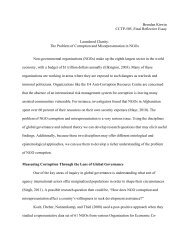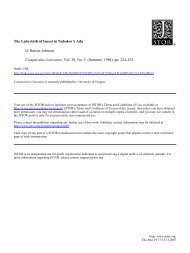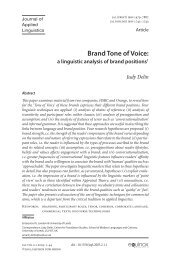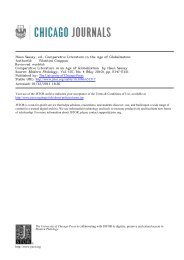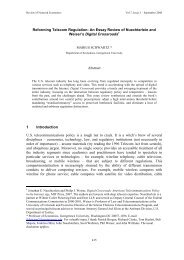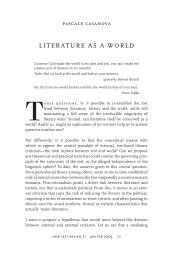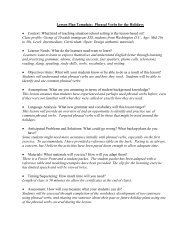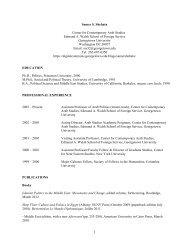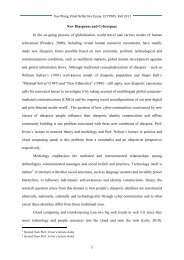roote-prokop-2013-g3-drosophila-genetics-training-all
roote-prokop-2013-g3-drosophila-genetics-training-all
roote-prokop-2013-g3-drosophila-genetics-training-all
You also want an ePaper? Increase the reach of your titles
YUMPU automatically turns print PDFs into web optimized ePapers that Google loves.
A. Prokop - A rough guide to Drosophila mating schemes 20<br />
Figure 14. The versatile Gal4/UAS system for targeted gene expression<br />
The Gal4/UAS system is a two component system where flies carrying Gal4-expressing constructs are<br />
crossed to flies carrying UAS-constructs (inset). Gal4 (black knotted line) binds and activates UAS<br />
enhancers (dotted-stippled lines), so that the pattern in which Gal4 is expressed (here ubiquitously in the<br />
fly) will determine the expression pattern of any genes downstream of the UAS enhancer (here ßGal or<br />
Ubx). The two components can be freely combined providing a versatile system of targeted gene<br />
expression. For example, Gal4-expressing constructs can be enhancer construct lines (a) or enhancer<br />
trap lines (b). The shown Gal4 lines are analogous to those in Fig. 12 with some modifications: these P-<br />
elements carry Gal4 instead of lacZ, the enhancer trap line is inserted into the ubiquitously expressed<br />
Act42A actin gene at cytogenetic map position 42A, and the enhancer element is the Act42A enhancer<br />
(actin-E) activating expression of Gal4 ubiquitously in the fly (black). Three examples of UAS lines are<br />
shown: c) P{UAS-lacZ,w + } carries a UAS enhancer in front of the lacZ reporter gene; d) P{UAS-Ubx,w + }<br />
carries the UAS enhancer in front of the Ubx gene; e) P{EP,w + }Ubx is an enhancer-promoter (EP) line<br />
with a random insertion into the Ubx locus at 89D (analogous to enhancer trap line in Fig. 12 A). P-<br />
elements of EP lines carry an UAS enhancer plus basal promoter which, on Gal4 binding, jointly activate<br />
genes that lie downstream of their random insertion sites (here the Ubx gene).<br />
d. FRT lines: FRT (FLP recognition target) sites are specific<strong>all</strong>y targeted by the yeast FLP<br />
recombinase ("flippase"). The FLP/FRT system is widely used in Drosophila as an inducible<br />
recombination system that has mostly replaced former X-ray based strategies [31,55]. It is<br />
used to excise genetic material (to activate/inactivate genes or markers) or to cause<br />
somatic recombination between homologous chromosomes, an event that would norm<strong>all</strong>y<br />
only occur during meiosis (Fig. 7). Somatic recombination requires specific insertions of FRTbearing<br />
P-elements close to the centromere of both homologous chromosomes. At these FRT<br />
sites, FLP will catalyse breakage and exchange of the homologous chromosome arms which<br />
can distribute into different cells in subsequent cell divisions. When starting from heterozygous<br />
individuals, this method can produce mosaic tissues with homozygous clones of cells<br />
surrounded by heterozygous cells [31]. Somatic recombination is used for MARCM (Mosaic<br />
Analysis with a Repressible Cell Marker) analysis studying the behaviour of single mutant<br />
cells or cell groups in normal or mutant tissue [56] (Fig. 15). Another important application is<br />
the generation of germline clones in female gonads (Fig. 16). Germline clones are an<br />
efficient strategy to generate matern<strong>all</strong>y mutant embryos, i.e. to circumvent the problem of<br />
maternal product [57]. Thus, mothers heterozygous for a homozygous lethal/sterile mutation<br />
may deposit maternal product, consisting in mRNAs and/or proteins of their healthy gene



